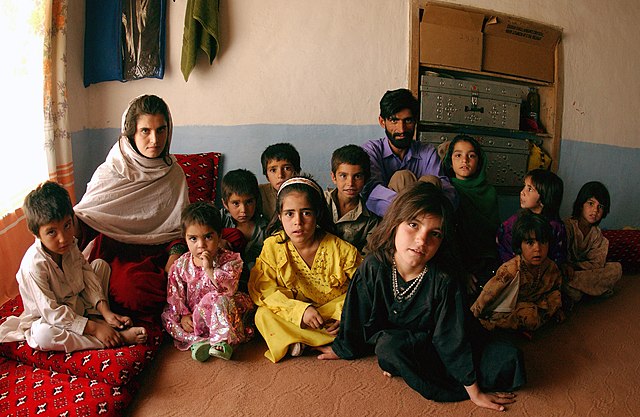Demographics of Afghanistan
The population of Afghanistan is around 41 million as of 2023. The nation is composed of a multi-ethnic and multilingual society, reflecting its location astride historic trade and invasion routes between Central Asia, South Asia, and Western Asia. Ethnic groups in the country include Pashtun, Tajik, Hazara, Uzbek, as well as smaller groups such as Baloch, Nuristani, Turkmen, Aimaq, Mongol and some others which are less known. Together they make up the contemporary Afghan people.
Sport fans inside the Ghazi Stadium in the capital of Kabul, which is multi-ethnic and the largest city of Afghanistan.
Young Afghans at a music festival inside the Gardens of Babur in Kabul.
An Afghan family from the Pashtun tribe in their home in Kabul
Gathering of students in 2006 at a school in Nangarhar Province.
Afghanistan, officially the Islamic Emirate of Afghanistan, is a landlocked country located at the crossroads of Central Asia and South Asia. Referred to as the Heart of Asia, it is bordered by Pakistan to the east and south, Iran to the west, Turkmenistan to the northwest, Uzbekistan to the north, Tajikistan to the northeast, and China to the northeast and east. Occupying 652,864 square kilometers (252,072 sq mi) of land, the country is predominantly mountainous with plains in the north and the southwest, which are separated by the Hindu Kush mountain range. Kabul is the country's largest city and serves as its capital. According to the World Population review, as of 2023, Afghanistan's population is 43 million. The National Statistics Information Authority of Afghanistan estimated the population to be 32.9 million as of 2020.
Tents of Afghan nomads in the northern Badghis province. Early peasant farming villages came into existence about 7,000 years ago.
A "Bactrian gold" Scythian belt depicting Dionysus, from Tillya Tepe in the ancient region of Bactria
Portrait of Ahmad Shah Durrani c. 1757
Afghan tribesmen in 1841, painted by British officer James Rattray








